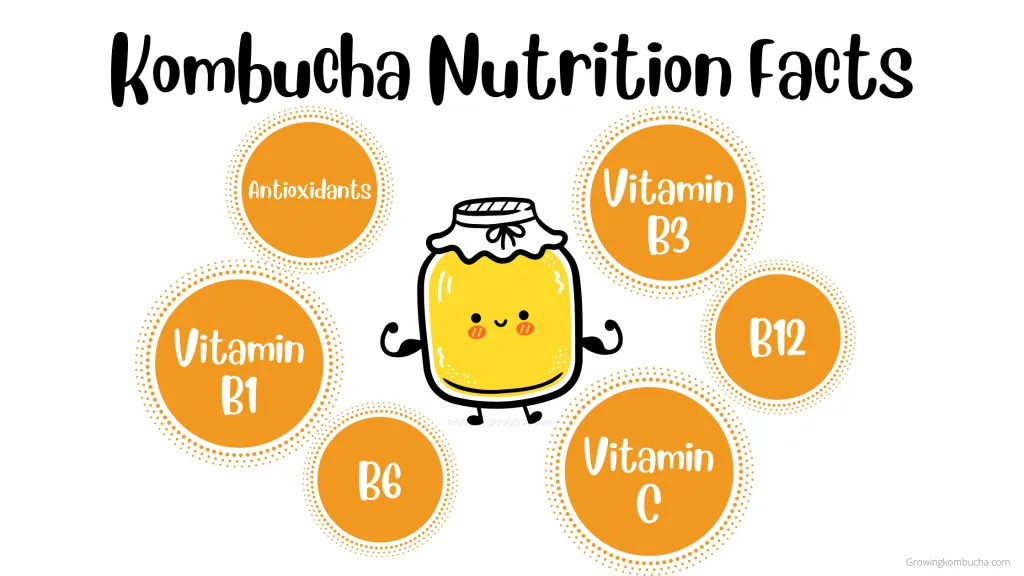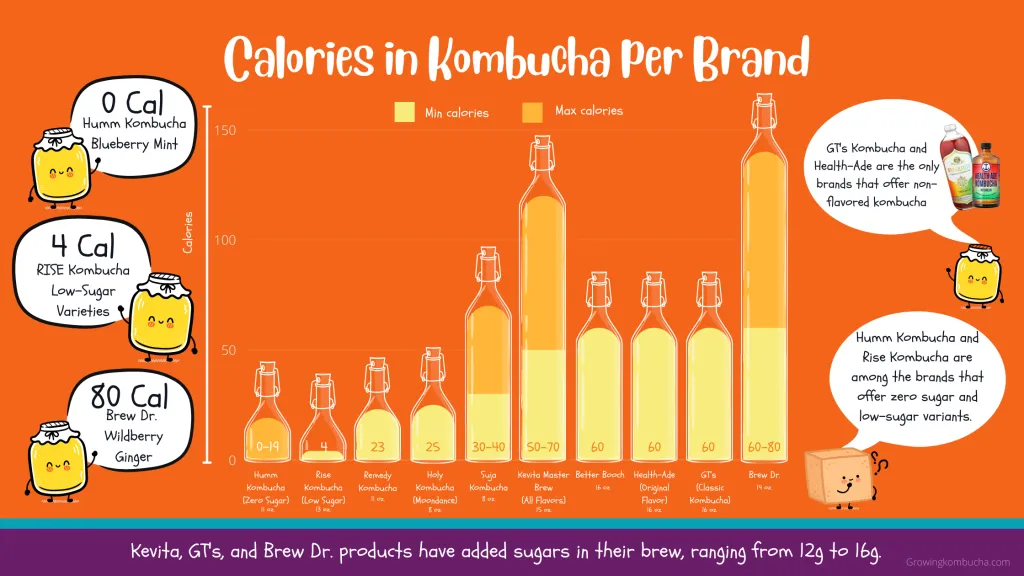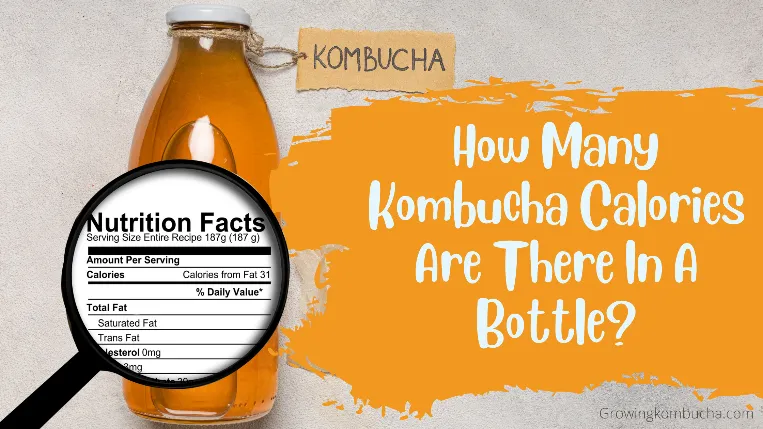Kombucha is now popular for being a healthier alternative to soda and other high-calorie drinks. With that, it’s only natural for the health-conscious to question how many kombucha calories can they get in a bottle of booch.
Through the rapid spread of information, consumers are now aware of the hidden marketing stunt of companies claiming that their products are “healthy”. In this post, we will share how many calories you can get in both home-brewed and store-bought kombucha.
We also ranked the top kombucha brands in the market based on their caloric content per bottle. To further explain how calories are adjusted, we also included the factors that drive the calories up and what constitutes a low-calorie kombucha.
If you want to incorporate kombucha into your weight loss plan or to manage diabetes, checking the calories per bottle is very crucial. It can be deceiving that since it’s kombucha, you won’t gain an extra pound, only to realize that it is the culprit why you have slow progress in your weight-loss journey.
The good news, however, is kombucha contains 86% fewer calories compared to a bottle of coke. It is also for that reason why many people are now considering kombucha as a healthy drink, not to mention the claims about its health benefits.
Q: Are there any calories in kombucha?
A: Yes and no. Most kombucha contains calories that range from 4 to 80. However, there are store-bought kombucha brands that filter and pasteurize their products to remove the calories. One of which is Humm Kombucha’s Blueberry Mint which contains 0 calories and 0 sugar, making it one of the best low-calorie kombucha on the market.
How calories are processed during kombucha fermentation
A calorie is the amount of energy from food and drinks. In kombucha, the caloric level is relative to the sugar level. During the fermentation, the amount of sugar decreases because of the consumption of yeast in SCOBY to produce ethanol and acids.
Since kombucha is a product of the mid-fermentation process, there is still some sugar left in the brew which gives kombucha a perfect blend of sweet and tart flavor. So, the final product of the first fermentation contains some calories but it is fairly low.
When you try to carbonate kombucha for the second fermentation, it will remain a low-calorie drink until you add some flavors. The exact amount of calories in homebrewed kombucha can be hard to gauge due to the following factors:
- It’s uncommon for homebrewers to measure calories in their brews. Usually, if a kombucha advocate wants calculated results, he/she should opt for store-bought kombucha where there is a label that indicates its contents.
- There is no standard when it comes to the taste of the brew. Some people brew longer than others because they want a more tart flavor. We will share the factors that change the calorie content of kombucha later in this post.
- Homebrewers have their preference in preparing the second fermentation of kombucha. Some kombucha advocates add honey and other sweet fruits to the brew which will increase the calories of the final kombucha.

Kombucha nutrition facts that you need to know
More than its low-sugar and low-calorie content, kombucha is rich in vitamins borne out of the fermentation process and from the nutrients in green and black tea. It contains the following:
- Vitamin B1 or Thiamine: Supports optimal cell function and conversion of food to energy.
- Vitamin B3 or Niacin: Helps lower cholesterol, boost brain function, and manage arthritis.
- Riboflavin: Necessary in the proper development of the skin, brain function, and lining of the GI tract.
- B6: Essential in the proper function of fat, sugar, and proteins in the body.
- B12: Keeps nerves and blood cells healthy,
- Vitamin C: Helps boost the immune system in fighting viruses and diseases.
- Antioxidants: Prevents the oxidation of cells and cell damage due to free radicals.
Calories in Store-bought kombucha
Since home-brewed kombucha has a lot of varying factors that affect its average caloric content, it’s another story for store-bought kombucha. In a survey that we conducted on the top ten kombucha brands in the market, the average calories in a 16 oz. bottle of kombucha is from 37.2 to 44.
Store-bought kombucha brands have more calories than homebrewed kombucha because they offer competitive flavors to the public. Most flavored kombuchas have a range of 50 to 70 calories. It is the reason why consuming more than one bottle of kombucha can break your recommended calorie intake if you are not checking the labels.
Comparing the calories in popular kombucha brands
If you are curious about the calorie content of kombucha brands in the market, we’ve listed them for you. In the image below, you may notice which brands have the lowest calories and which brands add sugar to their products.

Notable findings:
- Rise kombucha offers low-sugar options.
- Some of the brands have no classic kombucha flavors.
- The brands included in the analysis include multi-flavored varieties with added sugars, zero sugar varieties, and classic or original flavors.
Kombucha calories in homebrewed vs. store-bought kombucha

If you are to compare the calories in store-bought and home-brewed kombucha, the deciding factor lies in your control of the sugar level. Brewing your kombucha at home allows you to extend its fermentation duration to let the SCOBY eat more sugar.
Whereas, store-bought kombucha provides a wide selection of flavors with varying calorie content. Some are even sneaky and have some added sugar in them. If you can’t squeeze the preparation of kombucha into your tight schedule, there are some low-calorie and low-sugar store-bought kombucha options that you can also try.
To further compare the benefits of the two, here is a comparative list to help you achieve a better perspective:
Homebrewed Kombucha
- Freedom to control the sugar content that drives the calorie count per serving.
- Always available at home.
- Control the flavoring options.
- An assurance on no added sugar.
- Knowledge in experimenting with low-calorie kombucha recipes.
- Affordable to make.
Store-bought Kombucha
- Low-sugar and no-calorie options.
- Wide selection of flavors.
- Expensive but ready-to-drink.
- Labeling allows you to have calculated results.
Factors that affect kombucha calories
If you’re considering home brewing kombucha to monitor your calorie intake, it pays to know the factors that can lower calorie intake. These include:
Fermentation time
The longer you ferment kombucha, there will be less sugar in it. The SCOBY eats the sugar in the brew that is converted into ethanol and acid. Simply put, long fermentation of kombucha leads to kombucha vinegar.
The first fermentation of kombucha takes two weeks to finish. If you want the brew to have less sugar, you may extend it to a few more days.
Flavoring
The second fermentation of kombucha allows brewers to carbonate and add some flavors to kombucha. The sugar in fruits or ingredients that you add to kombucha will add more calories to it. Mango or other sweet fruits may tend to have more sugar content than ginger and other spices.
Temperature
Any kind of fermentation is sensitive to changes in temperature. It affects the activity of the yeast and good bacteria in converting sugar into alcohol and acid. Temperatures above 80 F make the SCOBY hyperactive in eating the sugar in the brew, making kombucha sour in a short time.
If the temperature is lower than 70 F, the SCOBY becomes sluggish and ferments the brew at a slower pace. In turn, the kombucha will taste sweeter and may contain more sugar and calories than usual. It is the reason why some brewers use a kombucha heating pad to acquire the optimal fermentation timeline for their brews.
Is kombucha good for you if you are counting your calorie intake?
Yes. Kombucha contains way fewer calories than other beverages like soda and fruit juices. It also contains vitamins and antioxidants that almost make it at par with other health drinks.
When home-brewing kombucha, you may put in as low as ¾ cup of sugar to feed the SCOBY, if you want to lessen the calories and sugar content. However, if you want something that contains no calories to be on the safe side of your diet, there are available store-bought kombucha that has zero calories and sugar.
Frequently Asked Questions (FAQs)
Is kombucha good for weight loss?
Yes, since it is low in calories and sugar compared to other beverages available on the market. Aside from its nutritional benefit, kombucha is also fizzy and comes in several flavors that most people on a specific diet can enjoy.
Is kombucha high in calories?
Some brands of kombucha are high in calories because of the flavoring and added sugar in the product. The range of calories in both homebrewed and store-bought kombucha is usually around 0 to 80 calories. In comparison to a bottle of soda, there’s about an 80% calorie difference, making it a better choice for people who are trying to lose or monitor their weight.
How many calories are in 250ml of kombucha?
A 250ml kombucha can have 0-40 calories, depending on the flavor and preparation of the brew. Some brewers extend the fermentation duration to decrease the sugar content.
Should I drink kombucha every day?
It is safe to drink kombucha every day as long as you don’t exceed the recommended daily consumption of 12 oz. Drinking too much kombucha may lead to some bad side effects like nausea, GI issues, and even death due to acidosis. To be on the safe side, consume kombucha in moderation.
Are two bottles of kombucha a day too much?
Two bottles of kombucha can be too much, especially if a bottle contains 16 oz. of kombucha. While some advocates claim that it is safe to drink as much kombucha as you want, the risks still outweigh the benefits. Try to limit your consumption to 12 oz. a day to keep the side effects at bay.
Why does kombucha have so few calories?
Kombucha has few calories because it undergoes the fermentation process where sugar is the food of the yeast. The sugar is turned into alcohol which later on becomes acid. Since kombucha only contains tea and sugar, the calories are mainly driven by the sugar content. So, a low-sugar kombucha also contains fewer calories, unless it is commercially filtered and pasteurized.
How many calories are in 16 oz kombucha?
A 16-ounce bottle of kombucha contains 60 calories based on the top three kombucha brands with 16 oz. bottles that include Better Booch, Health-Ade, and GT’s Kombucha. It may increase if you opt for a flavored kombucha that contains sweet ingredients like mango or berries.
Does kombucha make you poop?
Kombucha doesn’t contain fibers that can make you poop. However, it is rich in gut-healthy bacteria that may cause you to go regular. Due to fermentation, kombucha is believed to be a probiotic that helps promote a good balance in your gut bacteria. For that reason, your digestive processes become more efficient leading to better bowel movements.
How do you measure kombucha calories?
Calories are usually measured by a hydrometer or refractometer. However, if you’re at home and trying to measure the sugar in your brew, you can only make some estimates.
For example, a cup of white sugar initially added to a brew contains 774 calories. If you have a refractometer, check the amount of Brix in your brew and convert it to sugar. 1 Brix is equivalent to 1 gram of sugar. If you found 3 Brix in your homebrewed kombucha, it is equivalent to 3 grams of sugar which equates to 12 calories.
Can you drink too much kombucha?
Yes, drinking more than 12 oz. of kombucha is already above the daily recommended consumption by the CDC. One tip to avoid overdrinking kombucha is to divide a bottle into 4 servings throughout the day.
